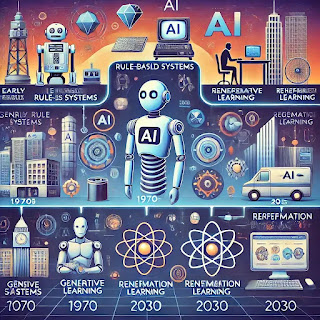Chomsky's Last Intellectual Debate?
Janpha ThadphoothonChomsky, a renowned linguist, emphasizes the importance of innate linguistic abilities and a deep understanding of language, which he believes AI models lack.
Now, let me invite you to the work of a Nobel prize laureate Jeff Hinton, an AI godfather - they say. Hinton, a pioneer in AI, particularly in neural networks, highlights the emergent capabilities of LLMs.
On the other hand, figures like Geoffrey Hinton highlight the transformative potential of LLMs, emphasizing their emergent abilities. These models, despite their lack of explicit programming to understand concepts, demonstrate skills such as contextual reasoning and stylistic imitation. Critics of Chomsky's views argue that the success of LLMs challenges the necessity of innate linguistic principles. They suggest that such systems can approximate understanding through their training on vast data sets, showing capabilities that resemble human-like behavior, even if derived differently.
LLMs and the neo-behaviorist Perspective
Stimuli-Response Dynamics: Behaviorists, including B.F. Skinner, viewed learning as the strengthening of responses to specific stimuli. Similarly, LLMs “learn” by adjusting weights in neural networks based on input-output pairings during training, which mirrors this behaviorist framework.
1. Understanding vs. Mimicry: Chomsky believes LLMs mimic language without understanding, while proponents argue that the models exhibit emergent properties indicating complex skill synthesis.
Who is winning?
1. Philosophical and Biological Consistency: Chomsky’s Universal Grammar theory has withstood decades of scrutiny and is deeply rooted in biology and cognitive science. His arguments that AI lacks genuine understanding resonate with those who view language as more than just statistical patterns.
- Practically: Hinton and the AI community are reshaping how society interacts with and understands language through technology.
Chomsky's Perspective on Language Acquisition
- Universal Grammar (UG): Chomsky argues that humans are born with an innate ability to acquire language, governed by a "universal grammar" hardwired into the brain. This framework provides the structures and rules necessary for language learning.
- Poverty of the Stimulus: He emphasizes that children acquire complex language structures despite limited exposure (or incomplete input), suggesting the existence of internal mechanisms that fill in the gaps.
- Critique of AI in Language Learning: Chomsky asserts that LLMs (like ChatGPT) and their statistical approaches are not analogous to how humans acquire or understand language because they lack an intrinsic grasp of grammar and semantics.
Hinton's (and AI's) Implications for Language Acquisition
- Pattern Recognition Over Innateness: Hinton’s work with neural networks implies that language acquisition might be more about recognizing and replicating patterns in large datasets (a process similar to AI training) than relying on innate mechanisms.
- Empirical Learning: Neural networks learn through exposure to massive amounts of data, resembling behaviorist theories where input (stimuli) and repetition shape learning. This contrasts with Chomsky’s claim that exposure alone is insufficient for language acquisition in humans.
- AI as a Model for Learning: Hinton’s perspective challenges Chomsky’s by showing that systems can generate meaningful linguistic output without innate grammar, calling into question the necessity of universal grammar for learning language.
Overlap and Tensions
- The debate implicitly examines whether humans acquire language via:
- Internal, biologically encoded rules (Chomsky).
- External data-driven processes of pattern recognition (Hinton/AI models).
While Chomsky’s theory focuses on human-specific biological mechanisms, Hinton’s AI-driven approach suggests that learning could be explained by exposure and interaction with linguistic data. This contrast invites further exploration into whether human language acquisition is unique or shares similarities with machine learning processes.
Geoffrey Hinton does acknowledge the role of biological factors, including genetics, in language development, but his focus primarily differs from Chomsky's. Hinton’s work centers on computational models and neural networks, emphasizing the power of learning from data and experiences rather than relying on strictly innate mechanisms.
Hinton’s Recognition of Nature in Language Development
1. Brain-Inspired Models:
- Hinton’s neural networks are based on how the brain functions, reflecting his acknowledgment of the biological foundations of intelligence, including language. These models simulate neurons and synaptic connections, inspired by human cognitive processes, which are ultimately rooted in our genetic makeup.
2. Initial Neural Capacities:
- Hinton recognizes that humans are born with certain innate capacities, such as the structure of the brain and the ability to form connections between neurons. This mirrors a basic form of nature's contribution, though he views these as general cognitive mechanisms rather than a language-specific module like Chomsky’s Universal Grammar.
3. Adaptation Through Experience:
- Unlike Chomsky, who emphasizes pre-wired linguistic structures, Hinton suggests that genetic predispositions provide the foundation for learning but that language itself is shaped largely by interaction with the environment and exposure to data.
Key Differences from Chomsky’s View
While Hinton doesn’t deny the influence of genetics, he diverges from Chomsky by:
- Downplaying the need for an innate, language-specific grammar.
- Highlighting the role of exposure and iterative learning in shaping linguistic abilities.
- Suggesting that human intelligence, including language, emerges from more general neural mechanisms rather than a pre-programmed linguistic blueprint.
Hinton acknowledges that nature plays a role in language development through the biological structures that facilitate learning, but he focuses on the adaptability and emergent properties of these systems. His work bridges the gap between acknowledging innate capacities and demonstrating how sophisticated learning arises primarily from data-driven processes. This creates a more empiricist view compared to Chomsky’s rationalist stance on Universal Grammar.












